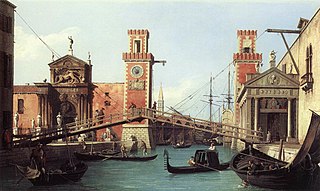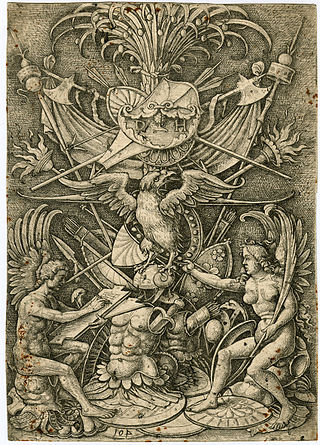
A rapier or espada ropera is a type of sword originally used in Spain The name designates a sword with a straight, slender and sharply pointed two-edged long blade wielded in one hand. It was widely popular in Western Europe throughout the 16th and 17th centuries as a symbol of nobility or gentleman status.
The spatha was a type of straight and long sword, measuring between 0.5 and 1 metre, with a handle length of between 18 and 20 centimetres, in use in the territory of the Roman Empire during the 1st to 6th centuries AD. Later swords, from the 7th to 10th centuries, like the Viking swords, are recognizable derivatives and sometimes subsumed under the term spatha.

An arsenal is a place where arms and ammunition are made, maintained and repaired, stored, or issued, in any combination, whether privately or publicly owned. Arsenal and armoury or armory are mostly regarded as synonyms, although subtle differences in usage exist.

The Royal Armouries is the United Kingdom's national collection of arms and armour. Once an important part of England's military organization, it became the United Kingdom's oldest museum, and one of the oldest museums in the world. It is also one of the largest collections of arms and armour in the world, comprising the UK's National Collection of Arms and Armour, National Artillery Collection, and National Firearms Collection. Originally housed in the Tower of London from the 15th century, today the collection is split across three sites: the Tower, the Royal Armouries Museum in Leeds, and Fort Nelson near Portsmouth.

Royal Armouries Ms. I.33 is the earliest known surviving European fechtbuch, and one of the oldest surviving martial arts manuals dealing with armed combat worldwide. I.33 is also known as the Walpurgis manuscript, after a figure named Walpurgis shown in the last sequence of the manuscript, and "the Tower manuscript" because it was kept in the Tower of London during 1950-1996; also referred to as British Museum No. 14 E iii, No. 20, D. vi.

The English language terminology used in the classification of swords is imprecise and has varied widely over time. There is no historical dictionary for the universal names, classification, or terminology of swords; a sword was simply a single-edged or double-edged knife.
A dirk is a long-bladed thrusting dagger. Historically, it gained its name from the Highland dirk where it was a personal weapon of officers engaged in naval hand-to-hand combat during the Age of Sail as well as the personal sidearm of Highlanders. It was also the traditional sidearm of the Highland Clansman and later used by the officers, pipers, and drummers of Scottish Highland regiments around 1725 to 1800 and by Japanese naval officers.
The baselard, Schwiizerdolch in Swiss-German is a historical type of dagger or short sword of the Late Middle Ages.

Skokloster Castle is a Swedish Baroque castle built between 1654 and 1676 by Carl Gustaf Wrangel, located on a peninsula of Lake Mälaren between Stockholm and Uppsala. It became a state museum in the 1970s and displays collections of paintings, furniture, textiles and tableware as well as books and weapons that amount to 20,000 items.

The Grandmaster's Palace, officially known as The Palace, is a palace in Valletta, Malta. It was built between the 16th and 18th centuries as the palace of the Grand Master of the Order of St. John, who ruled Malta from 1530 to 1798, and was also known as the Magisterial Palace. When the knights were expelled by Napoleonic France, it became the National Palace. During the period of British rule beginning in 1800, it was the Governor's Palace.

The Palace Armoury is an arms collection housed at the Grandmaster's Palace in Valletta, Malta. It was the main armoury of the Order of St. John in the 17th and 18th centuries, and as such it was the last arsenal established by a crusader military order. Although today only a part of the original armoury still survives, it is still one of the world's largest collections of arms and armour still housed in its original building. The Palace Armoury has been open to the public as a museum since 1860.

The Royal Armouries Museum in Leeds, West Yorkshire, England, is a national museum that holds the National Collection of Arms and Armour. It is part of the Royal Armouries family of museums, with other sites at the Royal Armouries' traditional home in the Tower of London, and the National Collection of Artillery at Fort Nelson, Hampshire. The Royal Armouries is a non-departmental public body sponsored by the Department for Culture, Media and Sport.

The basket-hilted sword is a sword type of the early modern era characterised by a basket-shaped guard that protects the hand. The basket hilt is a development of the quillons added to swords' crossguards since the Late Middle Ages. This variety of sword is also sometimes referred to as the broadsword, though this term may also be applied loosely and imprecisely to other swords.

The Royal Armoury of Madrid or Real Armería de Madrid, is a collection that, among many other things, contains the personal arms of the Kings of Spain, and also houses military weapons, armours and diplomatic works of art like mixed tapestries, paintings and other works of art and trophies. Among the most notable parts of the collection are armor and full tools that Charles V, Holy Roman Emperor and Philip II used. It is considered, along with the Imperial Armory of Vienna, one of the best in the world.

The Royal Armoury of Turin is one of the world's most important collections of arms and armour, formed in Turin by the Savoy family. The museum is now part of the Musei Reali di Torino, the royal site that has unified the Royal Palace, the Sabauda Gallery, the Archaeological Museum, the Royal Library and the Armoury. The whole site has been included on the UNESCO World Heritage list since 1997.

A trophy or trophy of arms in art and architecture is a real or depicted artistically assembled display of weaponry and other militaria, often captured from a defeated enemy, as an ornament designed for the purpose of triumphalist display by a victor or as a show of military prowess by a monarch. Similar decorative vertical arrangements of hunting accessories, musical instruments or other objects are also commonly referred to as trophies.

The Georgian Crown Jewels were the regalia and vestments worn by the monarchs of Georgia during the coronation ceremony and at other state functions. The last Georgian monarchs, Heraclius II and George XII, had their regalia invested, respectively in 1783 and 1798, from the Russian tsars, their official protectors. Of these royal jewels—a crown, sword, and scepter—only the latter staff survives, in the collection of the Kremlin Armoury in Moscow.
Ian Donald Dietrich Eaves,, is a British researcher and consultant on arms and armour. He served as the Keeper of Armour at the Royal Armouries for eighteen years, from 1978 to 1996. Also starting in 1978, and continuing until 1983, he served as the editor of the Journal of the Arms & Armour Society; he was appointed the society's president in 1995, and currently serves as a vice-president emeritus. He has written and translated several articles for journals, including the society's.
Terry English is a British armourer, mainly designing and making arms and armour, as well as props, for film and television productions. His work is held in museums such as the UK's Royal Armouries, and in private collections.
The Stahlrohrlanze is an obsolete German cavalry weapon issued in two variants, the M1890 and M1893nA. The German cavalry had been armed with a mixture of weapons until 1889, when it was decided that the entire corps would be issued lances. Initially wooden lances were issued, but in 1890 the first steel-tube lance was introduced. This was a 3.2-metre-long (10 ft) haft, with a 126-millimetre-long (5.0 in) quadrangular spear point. The M1890 has six eyelets below the point, which could be used to attach lance pennons. In 1893, a slightly modified lance, the M1893nA, was introduced. This included a leather tassel which could be used to carry the lance. The pennon eyelets were made larger and reduced to four. The M1890 remained in service with two eyelets removed to resemble the new weapon. The lances remained in use throughout the First World War, until they were removed from field service in 1927.














